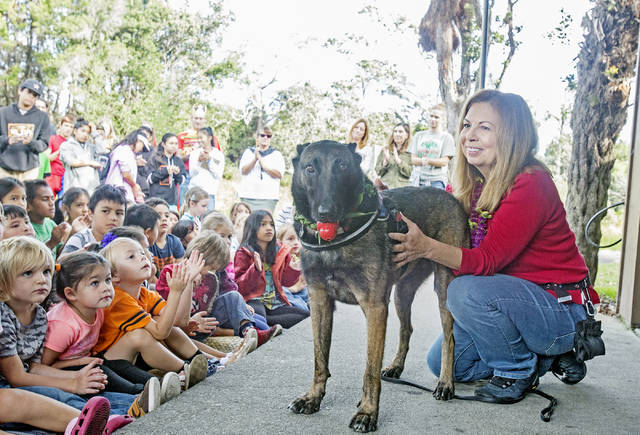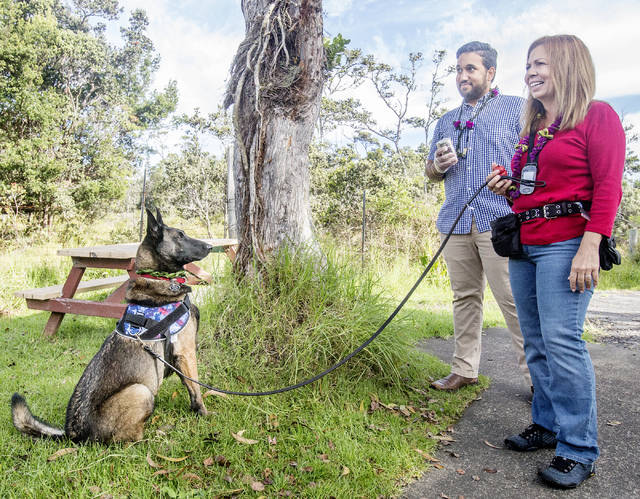As students at the Volcano School of Arts &Sciences sat quietly and watched, Cobra the Belgian Malinois led her handler, Lourdes Edlin, to a nearby tree on the school’s verdant campus.
Cobra was trained to detect a fungus that causes rapid ohia death and was demonstrating her abilities Wednesday morning at the school.
The dog took a moment and sniffed through the tall grass around the tree roots before she sat on the ground — her signal that she found the scent.
Wednesday was a kickoff demonstration of a new rapid response approach using dogs to detect the disease, a project funded by a grant from the state Department of Agriculture.
The project is being led by the U.S. Department of Agriculture Forest Service in partnership with USDA Agricultural Research Service, U.S. Geological Survey, Florida International University and Redland Ahead, a Florida-based nonprofit that specializes in training detection dogs.
It’s “a lot like creating an ohia guard dog,” said Kealoha Kinney, a research ecologist with the USDA Forest Service Pacific Southwest Station Institute of Pacific Island Forestry. The dogs are rapid response tools for monitoring ohia trees “that we hope will help slow the spread of the diseases.”
Kinney said the project is a feasibility study that aims to determine whether dogs can detect the scent, how accurate they can be and whether training tools that can carry the scent — but not the pathogen — can be developed.
So far, Kinney said they’ve been able to show that the dogs can pick up the scent and can be highly accurate. Additionally, they are using a material that allows the “smell of the infection to come out, but not the pathogen, so we can capture that smell on materials that we use to train the dogs with.”
Funding for the project was received last year, but this is the beginning of field trials.
Now that they’re able to demonstrate that dogs can identify ROD in materials and trees, Kinney said the next question is, “How do we scale this up so we can be as effective as possible? How do we turn this into an immediate conservation action?”
That includes the development of proficient detection dogs, handlers who can maintain that proficiency in detecting rapid ohia death and the ability to support those handlers and dogs with safe training tools.
Using the dogs as a detection tool will not only help contain the spread of rapid ohia death, but also identify trees that are infected but not yet symptomatic, providing an opportunity “to keep those trees and potentially save those trees,” Kinney said, which are not only critical to the ecosystem, but to Hawaii’s culture and heritage.
Dogs already are used to sniff out a fungus in Florida avocado trees. John Mills, president of Redland Ahead, said the fungus is similar to what is attacking the ohia trees.
“We do this in a lot of schools throughout Florida because we look at it as a long-term investment in fighting any invasive species,” he said about Wednesday’s demonstration.
In addition to seeing Cobra in action, students also learned a bit about how she was trained and the work she does.
“It’s a really great experience for them to find out about all the different ways that we’re trying to solve the rapid ohia death problem,” said Wade Heller, a VSAS parent who also works on detecting ROD at the USDA Daniel K. Inouye U.S. Pacific Basin Agricultural Research Center.
Kinney said the school is “kind of in the heart of it. They’re surrounded by ROD here, and it’s impacting this area, so they’re very concerned.”
As a place-based school, the focus is on learning from the environment, he continued.
“So we want to come here and expose students to part of the science of working with dogs and what they can do, but also the applications,” Kinney said. “And I think one thing I get out of this project is hope. There isn’t really any treatments out there for rapid ohia death and this is one way that we really have an opportunity to slow the spread and help our ohia trees. So we just wanted to expose students to that — the science, the training and the hope.”
Email Stephanie Salmons at ssalmons@hawaiitribune-herald.com.









